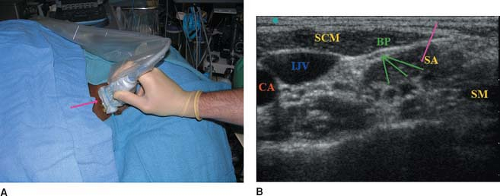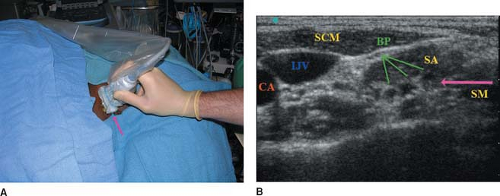Pediatric Ultrasound
Giovanni Cucchiaro
Introduction
The use of ultrasound for pediatric nerve blocks is especially useful because the blocks are often performed under general anesthesia. In small children (less than 30 kg) a high frequency transducer (7 MHz to 15 MHz) may be used for deep blocks such as sciatic and infraclavicular blocks as well as superficial blocks. The following probes are recommended.
25 mm linear array (6 MHz to 13 MHz): This probe is used for all blocks in children less than 15 Kg with the exception of infraclavicular blocks where a probe with a smaller footprint is useful. This probe is also useful for interscalene and supraclavicular blocks in larger children who weigh more than 30 kg.
11 mm curved array (4 MHz to 8 MHz): This probe is useful for infraclavicular blocks in children of all sizes because of its small footprint. The small footprint allows the user to place the probe near to the clavicle and still have room to manipulate the needle which is directed toward the plexus in a saggital plane superior to the probe. This probe may also be useful for sciatic blocks in the popliteal fossa and for femoral nerve blocks.
38 mm linear array (6 MHz to 13 MHz): This probe is useful for sciatic blocks in larger children.
1. Upper Extremities
Interscalene Nerve Block
A linear transducer is placed in a transverse position over the interscalene area (Fig. 43-1). The brachial plexus is visualized in cross section and a series of anechoic circles is seen between the anterior and middle scalene muscle and beneath the sternocleidomastoid muscle (Fig. 43-1). The block needle is inserted posterior to the probe using an in plane technique (Fig. 43-1). This technique is especially useful when the practitioner wishes to target the lower roots of the brachial plexus. This approach allows for direct visualization of
the needle in real time. When inserting a catheter for postoperative analgesia after shoulder surgery, the upper roots of the brachial plexus need to be blocked. In this setting, it may be preferable to insert the needle inferior to the probe using an out of plane technique (Fig. 43-2). The needle is directed cephalad to the plexus and the catheter is placed adjacent to roots C5 and C6. Diffusion of the local anesthetic around the roots is seen after injection (Fig. 43-3).
the needle in real time. When inserting a catheter for postoperative analgesia after shoulder surgery, the upper roots of the brachial plexus need to be blocked. In this setting, it may be preferable to insert the needle inferior to the probe using an out of plane technique (Fig. 43-2). The needle is directed cephalad to the plexus and the catheter is placed adjacent to roots C5 and C6. Diffusion of the local anesthetic around the roots is seen after injection (Fig. 43-3).
Infraclavicular Nerve Block
The landmark point for the infraclavicular nerve block is the coracoid process. With the arm abducted, to better expose the axillary vessels, the probe is placed 1 to 1.5 cm below
the coracoid process in the saggital plane. The needle is introduced superior to the probe and introduced nearly perpendicular to the skin (Fig. 43-4). The needle is advanced through the pectoralis major and minor muscles toward the lateral cord. Local anesthetic is injected around the lateral cord (Fig. 43-5). The needle is then redirected underneath the axillary artery to reach the posterior cord (Fig. 43-6). The same technique can be used to selectively block the medial cord. In older children it is useful to block each cord. In younger children it is sufficient to inject the local anesthetic around one cord and allow it to diffuse to the other cords.
the coracoid process in the saggital plane. The needle is introduced superior to the probe and introduced nearly perpendicular to the skin (Fig. 43-4). The needle is advanced through the pectoralis major and minor muscles toward the lateral cord. Local anesthetic is injected around the lateral cord (Fig. 43-5). The needle is then redirected underneath the axillary artery to reach the posterior cord (Fig. 43-6). The same technique can be used to selectively block the medial cord. In older children it is useful to block each cord. In younger children it is sufficient to inject the local anesthetic around one cord and allow it to diffuse to the other cords.
 Figure 43-2. The arrow shows the direction of the block needle, which enters the neck perpendicular to the longitudinal axis of the probe. The placement of a catheter using this approach to the brachial plexus will most likely result in positioning the catheter next to the higher roots of the brachial plexus (C5-C6). CA, carotid artery; IJV, internal jugular vein; SCM, sternocleidomastoid muscle; BP, brachial plexus; SA, anterior scalene; SM, middle scalene.

Full access? Get Clinical Tree
 Get Clinical Tree app for offline access
Get Clinical Tree app for offline access

|


